Related Research Articles

North Wales is a region of Wales, encompassing its northernmost areas. It borders mid Wales to the south, England to the east, and the Irish Sea to the north and west. The area is highly mountainous and rural, with Snowdonia National Park and the Clwydian Range and Dee Valley, known for its mountains, waterfalls and trails, wholly within the region. Its population is concentrated in the north-east and northern coastal areas, with significant Welsh-speaking populations in its western and rural areas. North Wales is imprecisely defined, lacking any exact definition or administrative structure. It is commonly defined administratively as its six most northern principal areas, but other definitions exist, with Montgomeryshire historically considered to be part of the region.

Rail transport in Wales began in the early 19th century initially used for industrial purposes and shortly began to be used for commercial purposes. The Beeching cuts had a significant impact on rail transport in Wales, closing a large number of railway stations. Since then some stations have reopened in Wales and following Welsh devolution, the Wales and Borders passenger rail franchise was established in 2001 and the operator was taken into public ownership by the Welsh Government in 2021.

The North Wales Main Line, also known as the North Wales Coast Line, is a major railway line in the north of Wales and Cheshire, England, running from Crewe on the West Coast Main Line to Holyhead on the Isle of Anglesey. The line has 19 stations, with all except two, Chester and Crewe, being in Wales.
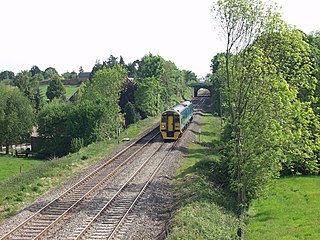
The Shrewsbury–Chester line is a railway line between Chester and Shrewsbury in England, with the line passing through Wrexham County Borough in Wales. Passenger train services are operated by Transport for Wales Rail between the northern terminal of Chester and Shrewsbury in the south as part of the Wales & Borders franchise. Some additional services, starting part way along the line to London Euston via Chester are operated by Avanti West Coast. The line was built in 1846 by the Shrewsbury and Chester Railway, with the engineer for the line being Henry Robertson, a partner in locomotive builders Beyer Peacock, while the contractor was Thomas Brassey in partnership with William Mackenzie and Robert Stephenson. The line is part of Transport for Wales' North Wales Metro improvement programme.
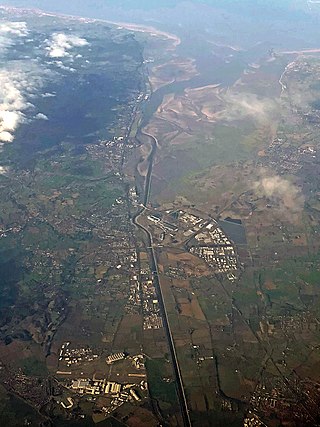
Deeside is the name given to a predominantly industrial conurbation of towns and villages in Flintshire and Cheshire on the Wales–England border lying near the canalised stretch of the River Dee that flows from neighbouring Chester into the Dee Estuary. These include Connah's Quay, Shotton, Queensferry, Aston, Garden City, Sealand, Broughton, Bretton, Hawarden, Ewloe, Mancot, Pentre, Saltney and Sandycroft. The population is around 50,000, with a plurality (17,500) living in Connah's Quay.
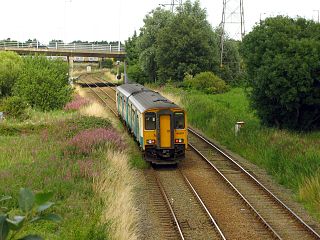
The Borderlands line, also known as the Bidston–Wrexham or Wrexham–Bidston line, is a railway line between Bidston on the Wirral Peninsula in England and Wrexham Central in the north-east of Wales. Passenger train services are part of the Wales & Borders franchise and are operated by Transport for Wales Rail. The line connects to the Merseyrail network at Bidston, the North Wales Coast Line at Shotton and the Shrewsbury–Chester line at Wrexham General. Parts of the line in Wales are used by freight trains, serving Deeside Industrial Park and the Hanson Cement works to the south of Buckley.

Shotton railway station serves the towns of Shotton and Connah's Quay, Flintshire, Wales. It is situated where the Borderlands Line crosses the North Wales Coast Line. All passenger services are operated by Transport for Wales, which manages the station.
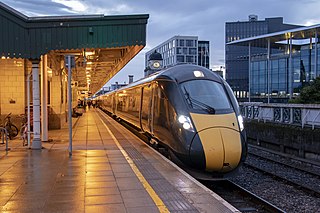
Transport in Wales is heavily influenced by the country's geography. Wales is predominantly hilly or mountainous, and the main settlements lie on the coasts of north and south Wales, while mid Wales and west Wales are lightly populated. The main transport corridors are east–west routes, many continuing eastwards into England.
Bristol is a city in south west England, near the Bristol Channel coast, approximately 106 miles (170 km) west of London. Several factors have influenced the development of its transport network. It is a major centre of employment, retail, culture and higher education, has many historic areas, and has a history of maritime industry. The city has a population of 450,000, with a metropolitan area of 650,000, and lies at the centre of the former County of Avon, which includes many dormitory towns, and has a population of one million.
Transport in Cardiff, capital and most populous city in Wales involves road, rail, bus, water and air. It is a major city of the United Kingdom and a centre of employment, government, retail, business, culture, media, sport and higher education.

Wrexham bus station is an eight-stand indoor bus station in Wrexham city centre on King Street. Services provide transit within the city, elsewhere in north Wales, and to Cheshire and Shropshire in England.

Bristol Supertram was a proposed light rail system for the Bristol and South Gloucestershire regions of England. In 2001, the project was given backing from the government to build a line that would link the city centre with the North Bristol region, but the project was cancelled in 2004.
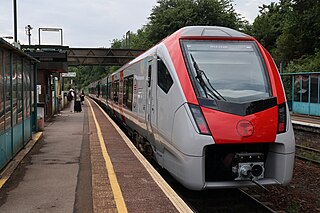
The South Wales Metro is an integrated heavy rail, light rail and bus-based public transport services and systems network currently being developed in South East Wales around the hub of Cardiff Central. The first phase was approved for development in October 2013. Works are currently under way, with a brand new depot under construction at Taff's Well and new trains being built by Stadler Rail in Switzerland. The development will also include the electrification of the core Valley Lines and new stations.

Northern Powerhouse Rail (NPR), sometimes referred to unofficially as High Speed 3, is a proposed major rail programme designed to substantially enhance the economic potential of the North of England. The phrase was adopted in 2014 for a project featuring new and significantly upgraded railway lines in the region. The aim is to transform rail services between the major towns and cities, requiring the region's single biggest transport investment since the Industrial Revolution. The original scheme would have seen a new high-speed rail line from Liverpool to Warrington continuing to join the HS2 tunnel which it would share into Manchester Piccadilly station. From there, the line would have continued to Leeds with a stop at Bradford. The line was intended to improve journey times and frequency between major Northern cities as well as creating more capacity for local service on lines that express services would have been moved out from.

North East Wales is an area or region of Wales, commonly defined as a grouping of the principal areas of Denbighshire, Flintshire, and Wrexham County Borough in the north-east of the country. These principal areas comprise most of the former administrative county of Clwyd. It is bordered by Conwy, and Gwynedd, in North West Wales to the west, Powys, in Mid Wales to the south, the English counties of Cheshire, and Shropshire to the east, and the Irish Sea, and Dee estuary to the north. It is the more urban, densely populated, and industrial part of the north Wales geographic region, centred on the city of Wrexham and the towns of Rhyl and Prestatyn, and the conurbation of Deeside. The region's close links with North West England in general and Merseyside in particular are crucial to the region's economy. The Clwydian Range and Dee Valley Area of Outstanding Natural Beauty is located in the region. Other attractions include historical buildings such as Chirk Castle, and Erddig in Wrexham, valley towns such as Corwen and Llangollen, and the Pontcysyllte Aqueduct and Canal World Heritage Site.
Deeside Parkway is a proposed railway station situated between Neston and Hawarden Bridge on the Borderlands Line. The station is intended to serve the Deeside area of Flintshire, North Wales, particularly the Deeside Industrial Park.
Wrexham North is a proposed railway station on the Shrewsbury–Chester line, situated between Rossett and Wrexham, in Wrexham County Borough, Wales. As of January 2022, there is no definitive site for the proposed station, with proposals including: the former Rossett railway station or a station near Pandy, Wrexham and Gresford. Unless construction of the station south of Rossett coincides with the full or partial dualling of the currently single track railway line towards Stansty, Wrexham North may be a single platform station or if situated at Rossett Junction be linked by a single track southwards to Wrexham.
Wrexham South is a proposed railway station on the Shrewsbury–Chester line, situated between Chirk and Wrexham, in Wrexham County Borough, Wales. As of January 2022, there is no definitive site for the proposed station, with proposals for the station to be located either near Johnstown or at Rhosymedre on the former Rhosymedre Halt railway station. If the latter location is decided, Ruabon would be the station closest to the south of Wrexham.

Broughton railway station is a proposed railway station on the North Wales Coast line, situated north of Broughton, Flintshire, Wales. Recent proposals for the station use a site north of Airbus UK's West factory site and Hawarden Airport, where the B5129 crosses the North Wales Coast line. Older proposals for the station include using the old sites of the former Sandycroft and Saltney Ferry railway stations.
References
- ↑ "250 new jobs for Wrexham as packaging company picks Llay for new HQ – £50m investment expected".
- ↑ "Welsh Government - North East Wales Metro". gov.wales.
- ↑ Barry, Sion (2 March 2017). "Vision revealed for a North East Wales Metro". Wales Online.
- ↑ Davidson, Tom (15 April 2016). "Where the North Wales Metro will - and won't - be stopping".
- ↑ "Arriva pulls out of Welsh rail bid". BBC News . 30 October 2017.
- 1 2 3 4 5 TfW Metro Development 2021 - How we're developing Metro (March 2021) (PDF). tfw.wales: Transport for Wales. March 2021. pp. 4, 7–8.
- ↑ Flint, Rachel (2016-02-21). "Carwyn Jones says North Wales Metro could happen in next ten years". North Wales Live. Retrieved 2021-03-15.
- ↑ Davidson, Tom (2016-04-15). "Where the North Wales Metro will - and won't - be stopping". North Wales Live. Retrieved 2021-03-15.
- ↑ "North east Wales metro: moving north Wales forward". GOV.WALES. Retrieved 2021-03-15.
- ↑ "Welsh Government sets out plans for a North East Wales Metro". Railway PRO. 2017-03-06. Retrieved 2021-03-15.
- ↑ Hughes, Owen (2019-09-13). "One new North Wales train station could be built - but three others dropped from shortlist". North Wales Live. Retrieved 2021-03-15.
- 1 2 3 "Introduction of new Class 230 trains on Wrexham to Bidston line delayed until next year". Wrexham.com. Retrieved 2021-09-16.
- ↑ Crump, Eryl (2020-07-22). "New train converted from London Underground stock finally spotted in North Wales". North Wales Live. Retrieved 2021-03-15.
- ↑ "North East Wales Metro details revealed as Ken Skates gives detail on Wales-wide 'transformation of transport'". Wrexham.com.
- ↑ "'Too many vehicles parking on the road'". BBC News. Retrieved 2018-10-30.
- 1 2 Bagnall, Steve (2019-12-19). "What you can expect from North Wales Metro scheme £20m cash injection". North Wales Live. Retrieved 2021-03-15.
- ↑ "Welsh Government £20m boost for North Wales Metro scheme". Deeside.com. Retrieved 2021-03-15.
- ↑ "Boost for North Wales Metro plans | Railnews | Today's news for Tomorrow's railway". www.railnews.co.uk. Retrieved 2021-03-15.
- ↑ Hughes, Owen (2020-06-17). "North Wales metro funding for electric buses and charging infrastructure". Business Live. Retrieved 2021-03-15.
- ↑ "Plans for new park and ride to ease congestion on Deeside Industrial Park backed for approval". Deeside.com. Retrieved 2021-03-15.
- ↑ "Work to begin next month on new Deeside park and ride scheme". Deeside.com. Retrieved 2021-03-15.
- ↑ "North Wales metro schemes benefit from over £11 million". GOV.WALES. Retrieved 2021-03-15.
- ↑ "£4m set side for Transport for Wales to develop 'North Wales Metro'". Nation.Cymru. 2020-10-22. Retrieved 2021-03-15.
- ↑ "Flintshire schemes benefit from share of £11m in North Wales metro funding". The Leader. Retrieved 2021-03-15.
- ↑ "Wrexham Gateway project set to receive £25m to support transformation of town's main railway station". The Leader. Retrieved 2021-04-06.
- ↑ Hughes, Owen (2021-03-24). "Snowdonia Transport Strategy and rail services get North Wales Metro funding boost". Business Live. Retrieved 2021-04-05.
- ↑ "£9m boost for North Wales Metro". GOV.WALES. Retrieved 2021-04-06.
- 1 2 3 "New images show true scale of ambitious North Wales metro programme". GOV.WALES. Welsh Government . Retrieved 2021-09-12.
- ↑ "New images show true scale of ambitious North Wales metro programme". thebangoraye.com. The Bangor Aye. 2021-09-10. Retrieved 2021-09-12.
- ↑ "WATCH: Welsh Government minister tells of benefits North Wales Metro will bring to area". The Leader. Retrieved 2021-09-12.
- ↑ Hughes, Owen (2021-09-10). "New images show true scale of ambitious North Wales metro programme". North Wales Live. Retrieved 2021-09-12.
- ↑ "North Wales Metro | Transport for Wales". tfw.wales. Retrieved 2021-09-12.
- 1 2 "North Wales Metro | Transport for Wales". trc.cymru. Retrieved 2021-03-15.
- ↑ Bhanot, Manisha (2021-03-10). "New railway station redevelopment project launched across north Wales". North Wales Live. Retrieved 2021-03-15.
- ↑ "'Lack of progress' fears multi-million pound North East Wales Metro project". Rhyl Journal. Retrieved 2021-03-15.
- ↑ "MS hits out over 'paltry sum' for North Wales Metro plan". North Wales Pioneer. Retrieved 2021-03-15.
- ↑ "Local MS challenges Minister over North Wales metro funding". www.baysideradio.co.uk. Retrieved 2021-03-15.
- ↑ "MS calls for greater 'urgency' over North Wales Metro plans". North Wales Pioneer. Retrieved 2021-11-09.
- ↑ "Welsh Government give £1bn Metro plan update – £50m so far for North Wales is a 'kick in the teeth'". Deeside.com. Retrieved 2021-11-09.
- ↑ Hughes, Owen (2021-10-22). "Welsh Government accused of neglecting North Wales in Metro spending commitments". Business Live. Retrieved 2021-11-09.